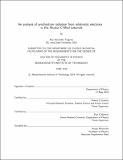| dc.contributor.advisor | Robert S Granetz and Earl S Marmar. | en_US |
| dc.contributor.author | Tinguely, Roy Alexander. | en_US |
| dc.contributor.other | Massachusetts Institute of Technology. Department of Physics. | en_US |
| dc.date.accessioned | 2020-01-08T19:31:03Z | |
| dc.date.available | 2020-01-08T19:31:03Z | |
| dc.date.copyright | 2019 | en_US |
| dc.date.issued | 2019 | en_US |
| dc.identifier.uri | https://hdl.handle.net/1721.1/123345 | |
| dc.description | This electronic version was submitted by the student author. The certified thesis is available in the Institute Archives and Special Collections. | en_US |
| dc.description | Thesis: Ph. D., Massachusetts Institute of Technology, Department of Physics, 2019 | en_US |
| dc.description | Cataloged from student-submitted PDF version of thesis. | en_US |
| dc.description | Includes bibliographical references. | en_US |
| dc.description.abstract | In the Alcator C-Mod tokamak, a magnetic confinement fusion experiment, electrons are accelerated to relativistic energies -- on the order of tens of MeV -- during steady-state conditions of Ohmic, elongated, and diverted plasma discharges. These so-called "runaway" electrons emit synchrotron radiation in their direction of motion due to their gyration in the background toroidal magnetic field, with values of B0 ranging from 2.7 to 7.8 T at the plasma axis. Two spectrometers, a wide-view camera, and a polarimeter are used to measure time-evolving spectra, images, and polarization information, respectively, of the synchrotron radiation in the visible/near-infrared wavelength range, [lambda] ~~ 300-1000 nm. The kinetic equation solver Code [Landreman et al 2014 Comput. Phys. Commun., Stahl et al 2016 Nucl. Fusion] and synthetic diagnostic Soft [Hoppe et al 2018 Nucl. Fusion] are used to model the evolution of the runaway electron phase space distribution and to simulate the detected synchrotron emission, respectively. The major contributions of this thesis work to the fields of plasma physics and fusion energy research are the following: Spectral measurements are consistent with runaway electrons' attaining lower energies as the magnetic field increases, a positive sign for future high-field fusion devices. The runaway electron density profile and other spatiotemporal dynamics, such as increased radial transport due to magnetohydrodynamic activity, are inferred from the two-dimensional synchrotron intensity distributions captured in camera images. Finally, for the first time in a tokamak plasma experiment, polarized synchrotron light is used as a novel diagnostic of the pitch angle distribution of runaway electrons. For all three measurements, discrepancies between experiment and theory/simulation are identified, and opportunities for future work are presented. | en_US |
| dc.description.statementofresponsibility | by Roy Alexander Tinguely. | en_US |
| dc.format.extent | 258 pages | en_US |
| dc.language.iso | eng | en_US |
| dc.publisher | Massachusetts Institute of Technology | en_US |
| dc.rights | MIT theses are protected by copyright. They may be viewed, downloaded, or printed from this source but further reproduction or distribution in any format is prohibited without written permission. | en_US |
| dc.rights.uri | http://dspace.mit.edu/handle/1721.1/7582 | en_US |
| dc.subject | Physics. | en_US |
| dc.title | An analysis of synchrotron radiation from relativistic electrons in the Alcator C-Mod tokamak | en_US |
| dc.type | Thesis | en_US |
| dc.description.degree | Ph. D. | en_US |
| dc.contributor.department | Massachusetts Institute of Technology. Department of Physics | en_US |
| dc.identifier.oclc | 1132722617 | en_US |
| dc.description.collection | Ph.D. Massachusetts Institute of Technology, Department of Physics | en_US |
| dspace.imported | 2020-01-08T19:31:01Z | en_US |
| mit.thesis.degree | Doctoral | en_US |
| mit.thesis.department | Phys | en_US |
